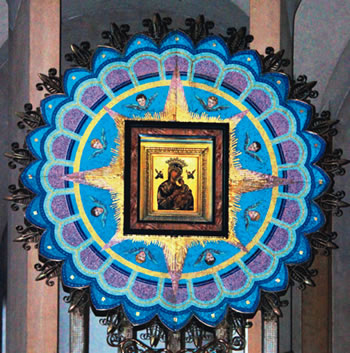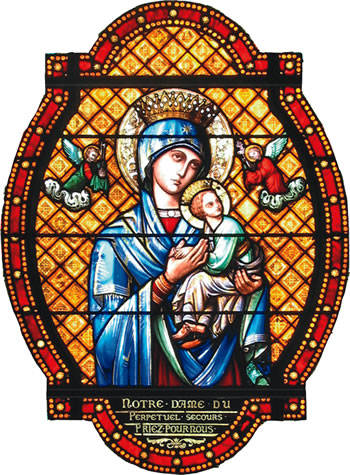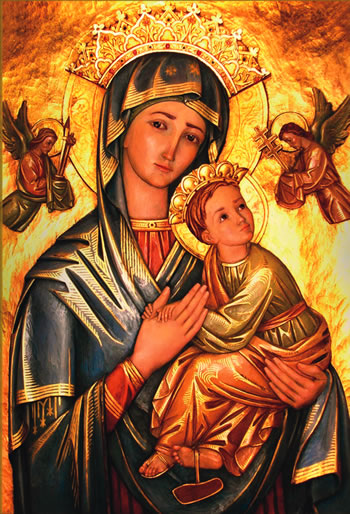Our Lady of Perpetual Succour

By Tricia O'Donnell
Our Lady of Perpetual Succour is familiar to most Catholics and, like many well-known pictures of Our Lady, it has a chequered past. It was believed to have been painted in the 15th century for the Greek Orthodox Church by an artist in Crete, although some think the image is much older, originating from St Luke himself.
A shrine on the Island of Crete became the home for the new painting and remained there until it was stolen at the end of the 15th century. It was taken to Rome and ended up in the home of a merchant who took ill a short while later. Just before he died, he decided its rightful place was in a church and entrusted it to a friend to carry out his wish. Instead, the friend kept it, placing it on his own wall. It is said that Our Lady appeared many times to the family, saying she wished the icon to be given to a church, and on one occasion she appeared to the man’s young daughter with instructions as to where she wished it placed. That place was the church of St Matthew the Apostle, between the basilicas of St Mary Major and St John Lateran, in Rome. The picture was finally installed on 27 March 1499, and was there for about 300 years.
St Matthew’s was destroyed in 1798 by Napoleon’s forces, but the icon was saved by the Augustinian friars, who took it to the Church of Santa Maria in Posterula. There it remained for almost 70 years. The arrival of the Redemptorist priests in 1855, when they unknowingly bought the site of the old St Matthew’s church for their headquarters, marked the beginning of the icon’s return ‘home.’ It was here, several years later, that they built the church of St Alphonsus Liguori.
By 1865, the connection between the icon and the site of St Matthew’s was known, and the debate started as to whether it should be returned to its original abode. On 11 December that year, Pope Pius IX, who had remembered the painting in St Matthew’s from his youth, decreed it should be displayed in St Alphonsus Ligouri church. This was, after all, the place where Mary had originally wished it to be. The pope’s instructions to the Redemptorists were to supply the Augustinians with a replacement picture of the image, along with the mission to tell the world about Our Lady of Perpetual Succour.
The homecoming took place on 26 April 1866 amid huge celebrations. Flowers and banners were strewn along the roads leading to the church, and a procession made its way there to watch the placing of the icon over the altar. Miracles were said to have occurred over the three days of festivities, when hundreds of pilgrims came to pay honour to Our Lady. Two months later, the image received a Canonical Coronation, when on 23 June 1867, golden, jewelled crowns were affixed to Mary and her Son on the icon.

Our Lady of Perpetual Help, Baclaran Shrine, Paranaque City, Manila
Photo: Dennis Natividad
A hundred and fifty years later, the icon can still be found in the church of St Alphonsus in Rome. The Redemptorists take their responsibility for this precious artefact seriously, and have overseen its restoration, as well as carrying out their promise to publicise the image throughout the world. Our Lady of Perpetual Help, as it’s also known, is one of the most popular portrayals of Mary within the Catholic Church. Countries and towns worldwide have shrines dedicated to her, from the United States to the Philippines, Haiti, Spain and the United Kingdom.
In other cultures the icon is known as Notre dame du Perpetuel Secours, Nuestra Senora del Perpetuo Socorro and Ina ng Laging Saklolo.
Filipino Catholics know and revere her as Our Lady of Baclaran, and display the icon in churches throughout the country with a special dedication in the National Shrine of Our Mother of Perpetual Help in Baclaran, Paranaque City, Metro Manila, which holds a German version of the painting. Churches throughout the country still hold regular Novenas, Masses and Benedictions in honour of Our Lady with special emphasis on the traditional Wednesday Novena.

Our Lady of Perpetual Succour
Église St-Pierre, Chartres, France
It’s easy to glance at this painting as just another portrayal of the Madonna and Child, albeit an icon rather than a true-to-life version. However, there is a remarkable amount of detail on which to ponder and reflect. The original Byzantine icon held in St Alophonsus in Rome is painted on a piece of solid wood measuring approximately 43cm x 54cm. Time may have taken its toll on this once stunning piece of art, but its popularity has never waned.
Pilgrims still travel from far and wide to view the icon, which shows Mary and Jesus on a background of gold. Mary’s red dress and dark blue mantle with streaks of gold are quite different from the usual pastel shades in which she is often depicted. All the colours chosen, however, were deliberate. It is believed that red represents divinity, while blue is for humanity; the addition of green in the lining of her mantle relates to Mary’s Queenship, as red and green relate to royalty. This also applies to the green tunic and red sash worn by Jesus, as it is said that these were characteristic of those worn by Byzantine emperors.
There’s a sad, apprehensive air about the image, marked by Mary’s sorrowful expression as her Son clings to her, both hands in her right hand, while her left hand cradles Him. Jesus appears older than other depictions of Mother and Child which, together with an almost fearful demeanour, indicate an awareness of the suffering to come. This is reinforced by two archangels hovering in the background. On the left, St Michael holds a lance and a sponge, while St Gabriel, on the right, carries nails and a cross. Because of these inclusions, in the Eastern Orthodox Church, the image is known as the Theotokos, the God-bearer, of the Passion.
In the various reproductions of the icon over the years, there have been slight changes. Sometimes in the colourings, deeper reds and golds, sometimes in the details: haloes were added to Mary and her Son, something not included on the original, as it was not general practice to paint these on holy pictures. In some images, Mary’s expression is a little softer, taking away some of the sadness originally depicted. In Byzantine art three stars are added to Mary’s mantle, one on each shoulder and one on her forehead, while in most other versions, there is only one star
on her forehead, which it’s believed represents her role as
Star of the Sea.
 All images include the loose sandal, falling from the foot of Jesus. Several explanations are suggested for this, ranging from a frightened Child running to his mother on seeing the figures of the Archangels, to the symbolism of the sandal in Scripture (Ruth 4: 7-9 and Exodus 3:5) and in Oriental iconography. However, most seem to agree that the position of Mary’s hand, while holding her Child’s, is pointing towards Him, leading us, as she always does, to her Son.
All images include the loose sandal, falling from the foot of Jesus. Several explanations are suggested for this, ranging from a frightened Child running to his mother on seeing the figures of the Archangels, to the symbolism of the sandal in Scripture (Ruth 4: 7-9 and Exodus 3:5) and in Oriental iconography. However, most seem to agree that the position of Mary’s hand, while holding her Child’s, is pointing towards Him, leading us, as she always does, to her Son.
This powerful icon has so many messages that it is deserving of serious reflection, but one message stands out. As Our Lady of Perpetual Succour or Perpetual Help, that’s exactly what she is -- our ever-present support in times of trouble. Perhaps that’s what the artist wanted to convey to us, that just as her Son fled to her in His distress, so are we to do. This 15th century icon is still talking to us, should we take the time to listen.
The feast of Our Lady of Perpetual Succour is on 27 June.
 Entries(RSS)
Entries(RSS)